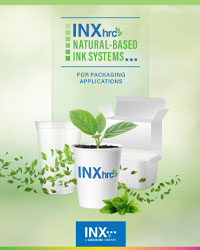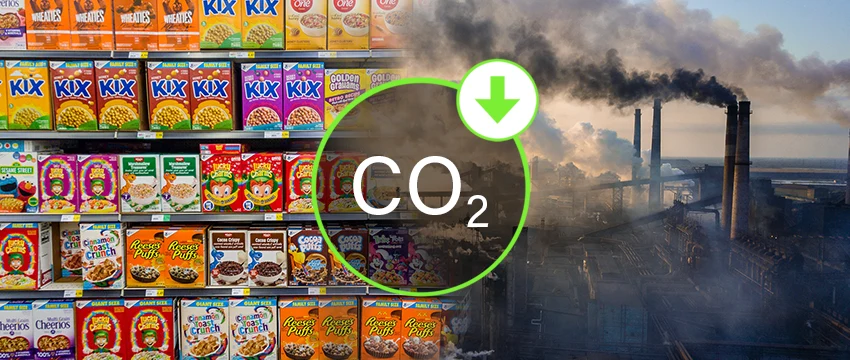Using Eco-Friendly Inks to Reduce Carbon Footprint
Is your organization ready for mandatory CO2 disclosure?
It’s second nature to check nutritional information on packaging, so why not check the carbon footprint too? Using eco-friendly inks and collaboration between material suppliers, brand owners, and packaging converters is vital in supporting the need to reducing our carbon footprint. One of the ways INX supports the goal of lowering CO2 emissions, is by developing eco-friendly inks which reduce regulatory risks and have measurable, reportable CO2 savings.
Consumers and Investors Want Sustainability Goals
Consumers are increasingly worried about our planet and continue to demand more sustainable products and services. The Carbon Trust conducted research into consumer buying habits and found that 45 percent of shoppers would be prepared to stop buying their favorite brands if the company refused to commit to measuring their product carbon footprint. Brand loyalty is also at stake - 56 percent of people would be more loyal to a brand if they could easily see that the company was actively working to reduce its carbon footprint.1
Companies have responded by establishing sustainability goals–many of which include a reduction in CO2 emissions. Nine global brands recently joined the Supplier Leadership on Climate Transition (Supplier LoCT), a consortium created to accelerate action throughout the supply chain toward net-zero greenhouse gas (GHG emissions). Established in April 2021, the Supplier LoCT has gained significant momentum and expanded beyond its three founding members—Mars, Pepsico, and McCormick & Company—to 12 corporations with the addition of Atlantic Packaging, The Coca-Cola Company, The Estée Lauder Companies, General Mills, Keurig, Dr Pepper, Mondelez International, Nestlé, Restaurant Brands International, and Yum! Brands.2
Carbon footprinting has also gained attention and concern from the investor community. A proposed SEC rule was recently released (March 2022) that would require publicly traded companies to disclose to investors climate metrics, including targets and goals, greenhouse gas emissions, “climate-related risks” impact on business and operations, and the mitigation efforts being deployed.3 Investors, like consumers, are “walking their talk.” For example, in a recent podcast produced by McKinsey, Ron O’Hanley, president and CEO of State Street Corporation and a major servicer and manager of institutional assets, indicated that State Street has committed to making its portfolios carbon neutral by 2050.4
Eco-Friendly, Natural-based Inks
We anticipate that brand owners and their suppliers will be required to address the carbon footprint of packaging materials (including its inks and coatings) in a more transparent way. One of the ways INX helps lower CO2 emissions is by developing eco-friendly, natural-based inks. Natural-based, renewable materials that are responsibly sourced and considered for their end-of-life recovery provide a path to measurable, reportable CO2 savings and ultimately help brands tell a stronger sustainability story. By increasing the biorenewable content of our products, we reduce the effective carbon footprint of our inks and our company’s reliance on finite oil resources.

INXhrc™ high-performance, natural-based inks for flexographic, offset, and gravure applications are formulated to replace petrochemically derived ingredients with clean, renewable, and sustainable ingredients without sacrificing machine, processing, and end use product performance. They contain 50 to 90 percent natural ingredients and are free of allergens, nanomaterials, fluorochemicals, fanal pigments, heavy metals, latex, and PTFE. They have a 25 to 30 percent lower CO2 footprint than standard aqueous inks.* In addition to reducing their carbon footprint, brand owners and printers realize additional benefits, such as increased ink mileage, sharper graphic images, less scrap generated, and more machine up-time.
Dart Container, a long-time INX customer committed to producing sustainable packaging and enhancing their efforts to reduce carbon emissions, switched from traditional packaging inks to INXhrc inks. The impact of INXhrc ink on Dart Container’s environmental footprint was immediate and substantial. Since the switch (and without an increase in cost) Dart has achieved the following through its use of INXhrc:
- Reduced more than 200 tons of C02 emissions
- Reduced VOC emissions by 75 percent
- Reduced their regulatory risk and potential liabilities
Conclusion
As new regulations emerge in response to global consumer and investor concerns, we expect the performance of a business will be based in no small part on doing its part to save our planet. And yet, no one organization can protect our planet and achieve game-changing sustainability goals by going at it alone. While adding carbon footprints to the consumer experience may require an investment in time and resources, the data demonstrates that when designed effectively, it can certainly have the potential to increase sales for brands and margins for retailers.5
We understand how we fit into the bigger sustainability picture with consumers, brand owners, converters, and our planet. As consumer demands and regulatory requirements multiply, we are committed to enhancing and growing our leadership position in the industry and addressing the needs of brand owners, customers, and consumers by improving the sustainability of our products and refining the systems that measure the sustainability impacts of our business. Coloring a Safe and Sustainable Future (CSSF) is the model we use to illustrate how sustainability is integrated into both the strategic as well as the day-to-day activities of our business. It serves to guide us as we work to improve our sustainability performance while collaborating with material suppliers, brand owners, and packaging converters to reduce the carbon footprint of packaging materials.
*Based on EUPIA dry ink baseline for aqueous based inks of 3.092kg CO2/kg dry ink.
1Consumer demand for lower-carbon lifestyles is putting pressure on business, CarbonTrust.com
2Coca-Cola, General Mills Join Supplier Leadership on Climate Transition, EnvironmentalLeader.com
3Press Release, U.S. Securities and Exchange Commission, SEC.gov
4Forward Thinking on sustainable and inclusive growth with Ron O’Hanley, McKinsey.com
5Will Carbon-Labeled Products Sell More? Here’s What We Know, SustainableBrands.com









![Shrink Labels and Recycling [Shrink labellled bottles]](/sites/default/files/styles/large/public/2024-04/INX_shrink_blog850x360.jpg?itok=Qsx6qEqs)






